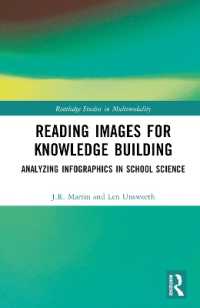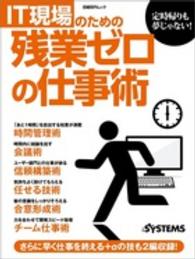基本説明
Presents a cafefully calibrated history of U.S. immigration in primary source documents. More than 50 documents, each with notes explaining its context, significance, and effects, identify the major waves of immigration.
Full Description
The uncomfortable contemporary realities of immigration, enmeshed as they are in economic, human rights, and national security issues, have once again propelled foreign immigration to the United States toward the top of the list of U.S. domestic policy concerns. Three respected authorities on immigration and international affairs here present a carefully calibrated history of U.S. immigration in primary source documents, tracing the roots of the current debate in the history of our profoundly divided and surprisingly cyclical response to foreign immigration. This book documents this national ambivalence, identifying the major waves of immigration and clarifying the ways in which the existing social and political fabric conditioned both the response to the newcomers and their prospects of eventual integration into American society.
Part I introduces the historical record:
• The early days of the Republic, when most immigrants arrived from northern Europe
• The most important wave of immigration to the United States in the country's history, over 1880-1920, when most immigrants arrived from Asia or from southern and eastern Europe
• Virulent post-World War I anti-immigration sentiment
• The World War II-era absorption of huge numbers of displaced persons fleeing the misery and devastation of Europe
• Transition from a quota system to a preference system
• Heightened debate in the 1980s and 1990s
• The immigration policy repercussions of the terrorist attacks of September 11, 2001
Part II takes up special issues in the contemporary immigration debate, including the security debate and immigration, immigration and the U.S. judiciary, the immigration debate and the economy, and the spectrum of public opinion on immigration revealed during the 2008 presidential election campaign. The authors demonstrate that today's highly polarized immigration reform debate in many respects recapitulates the antagonisms and chaotic policies of the 1980s and 1990s, when Ronald Reagan's Republican administration implemented an amnesty program while the state of California adopted the punitive Proposition 187.
Paramount in today's immigration debate, however, are the homeland security concerns rendered acute by the 2001 bombing of the World Trade Center in New York City. The controversial USA PATRIOT Act of 2001 and the Homeland Security Act of 2002 are among the documents surveyed in relation to the contemporary immigration debate.
General introduction to the historical period or thematic topic of each chapter
More than 50 documents, each with notes explaining its context and significance
Sidebars featuring historical background notes and intriguing sidelights
Further Reading lists presenting print and electronic resources recommended for further study
25 black-and-white illustrations
Contents
Acknowledgements Introduction Part I Chapter 1 - Immigration from Colonial Times to the Revolution by David Felsen Chapter 2 - Immigration and Americas Expansion in the 1800s by David Felsen Chapter 3 - The Great Wave of Immigration from 1880 to 1920 by David Felsen Chapter 4 - Immigration to the United States during the 1920s and 1930s by Akis Kalaitzidis Chapter 5 - Immigration in the Early Post-War Period by Akis Kalaitzidis Chapter 6 - From the Quota System to the Preference System by Akis Kalaitzidis Chapter 7 - The Growing Immigration Debate in the 1980s and 1990s by Akis Kalaitzidis Chapter 8 The Response to Immigration after September 11, 2001th by David Felsen Part II Chapter 9 - Mexico, Mexicans, and the U.S. Immigration Debate by David Felsen Chapter 10 - The Security Debate and Immigration by Thomas Cieslik Chapter 11 - The Judiciary and U.S. Immigration Policy by Thomas Cieslik Chapter 12 - The Immigration Debate and the U.S. Economy by Thomas Cieslik Chapter 13 Immigration and the 2008 Presidential Campaign of 2008 by Thomas Cieslik Conclusion








